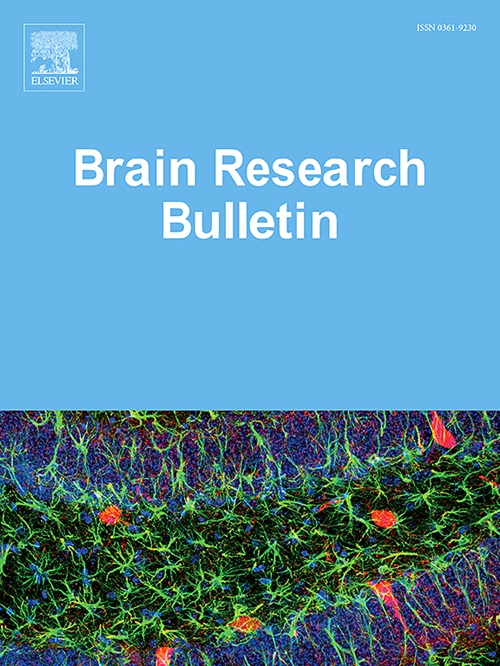40赫兹的振动刺激可抑制Aβ诱导的SH-SY5Y、BV2细胞和周细胞的变化。
IF 3.5
3区 医学
Q2 NEUROSCIENCES
引用次数: 0
摘要
阿尔茨海默病(AD)是一项重大的社会挑战,但目前尚无确切的治疗方法。经颅磁刺激和经颅直流电刺激等非侵入性脑刺激方法有望缓解与神经退行性疾病相关的认知症状。本研究使用 SH-SY5Y 神经母细胞瘤细胞、原发性人脑周细胞和 BV2 小胶质细胞研究了 40Hz 振动触觉刺激对注意力缺失症相关细胞反应的影响。用低聚β-淀粉样蛋白(Aβ)处理的SH-SY5Y细胞和脑周细胞接受了不同持续时间的40赫兹振动刺激。通过 CCK-8 试验测定细胞活力,同时评估周细胞的细胞内钙水平。蛋白质表达采用 Western 印迹法测定,基因表达则通过实时定量聚合酶链反应进行量化。为确保精确刺激,采用了详细的振动参数。值得注意的是,40Hz 振动刺激提高了暴露于 Aβ 的 SH-SY5Y 细胞的存活率,降低了 Aβ 处理的周细胞的细胞内钙离子(Ca2+)水平,激活了自噬,并减轻了 SH-SY5Y 细胞中 tau 的高磷酸化。此外,它还在 BV2 小胶质细胞中表现出抗神经炎症的特性。这些发现凸显了40Hz振动触觉刺激作为AD治疗策略的潜力。本文章由计算机程序翻译,如有差异,请以英文原文为准。
Vibrotactile stimulation at 40 Hz inhibits Aβ-induced changes in SH-SY5Y, BV2 cells, and pericytes
Alzheimer’s disease (AD) poses a major societal challenge, yet no definitive cure exists. Noninvasive brain stimulation methods, such as transcranial magnetic stimulation and transcranial direct current stimulation, have shown promise in alleviating cognitive symptoms associated with neurodegenerative disorders. This study investigated the effects of 40 Hz vibrotactile stimulation on AD-related cellular responses using SH-SY5Y neuroblastoma cells, primary human brain pericytes, and BV2 microglia. SH-SY5Y cells and brain pericytes treated with oligomeric beta-amyloid (Aβ) underwent 40 Hz vibrational stimulation for varying durations. Cell viability was determined via the CCK-8 assay, while intracellular calcium levels in pericytes were assessed. Protein expression was measured using western blotting, and gene expression was quantified via a real-time quantitative polymerase chain reaction. Detailed vibrational parameters were employed to ensure precise stimulation. Notably, 40 Hz vibrotactile stimulation improved cell viability in Aβ-exposed SH-SY5Y cells, reduced intracellular calcium ion (Ca2+) levels in Aβ-treated pericytes, activated autophagy, and mitigated tau hyperphosphorylation in SH-SY5Y cells. Additionally, it exhibited anti-neuroinflammatory properties in BV2 microglia. These findings highlight the potential of 40 Hz vibrotactile stimulation as a therapeutic strategy for AD.
求助全文
通过发布文献求助,成功后即可免费获取论文全文。
去求助
来源期刊

Brain Research Bulletin
医学-神经科学
CiteScore
6.90
自引率
2.60%
发文量
253
审稿时长
67 days
期刊介绍:
The Brain Research Bulletin (BRB) aims to publish novel work that advances our knowledge of molecular and cellular mechanisms that underlie neural network properties associated with behavior, cognition and other brain functions during neurodevelopment and in the adult. Although clinical research is out of the Journal''s scope, the BRB also aims to publish translation research that provides insight into biological mechanisms and processes associated with neurodegeneration mechanisms, neurological diseases and neuropsychiatric disorders. The Journal is especially interested in research using novel methodologies, such as optogenetics, multielectrode array recordings and life imaging in wild-type and genetically-modified animal models, with the goal to advance our understanding of how neurons, glia and networks function in vivo.
 求助内容:
求助内容: 应助结果提醒方式:
应助结果提醒方式:


